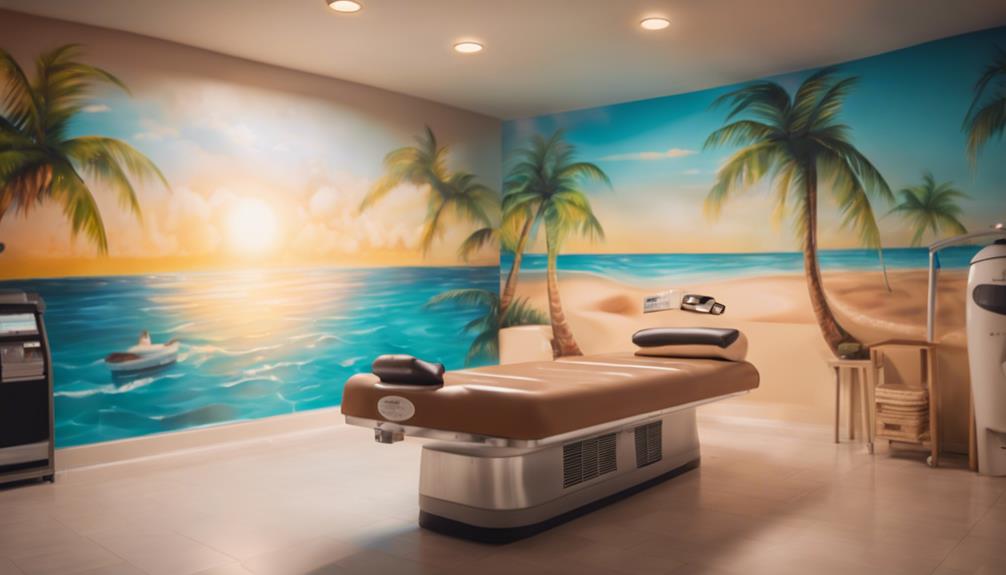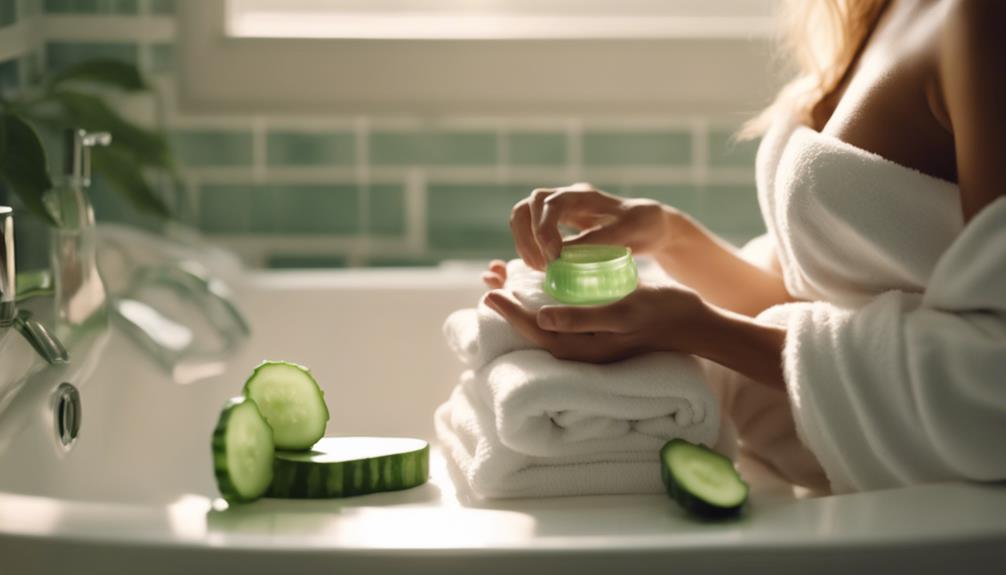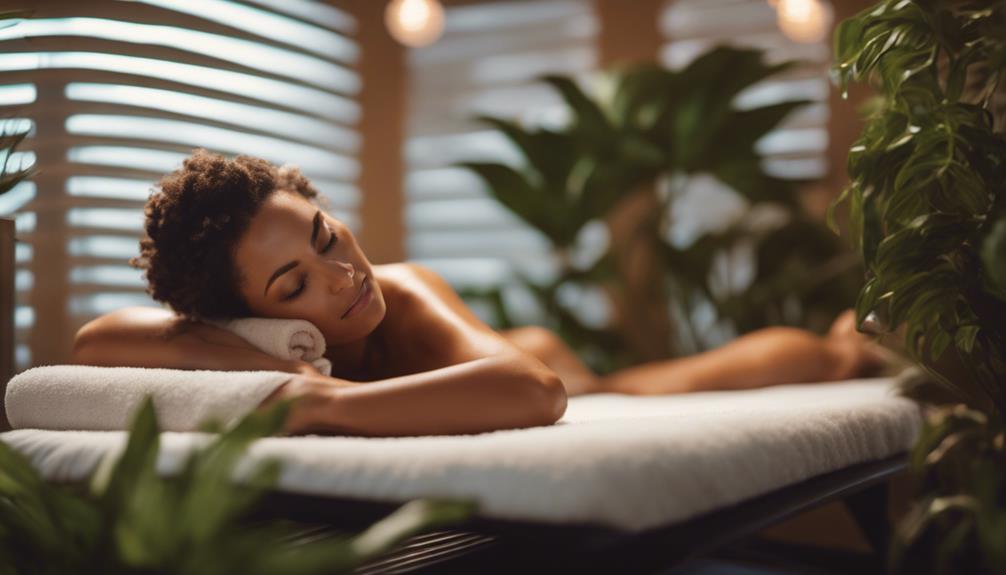Mastering safe tanning bed sessions means knowing your skin type and choosing the right bed level. If you have fair skin, limit your first session to just 5-10 minutes. Medium skin types can usually handle up to 20 minutes. Always wear protective eyewear and use tanning lotions to moisturize your skin and boost your tan. Stay hydrated before and after your sessions to keep your skin healthy. After tanning, apply a moisturizer to lock in hydration and avoid hot showers for 24 hours. By following these tips, you can achieve a beautiful tan while minimizing risks—there's more to discover!
Key Takeaways
- Determine your skin type and adjust initial tanning bed sessions to minimize burn risk and ensure safety.
- Use protective eyewear during sessions to safeguard your eyes from harmful UV rays.
- Apply appropriate tanning lotions to nourish your skin and enhance your tan effectively.
- Stay hydrated before and after tanning to maintain skin health and prevent dryness.
Importance of Skin Type
Understanding your skin type is essential for safely enjoying tanning bed sessions and avoiding burns or peeling. Knowing whether you have fair, medium, or dark skin helps you tailor your tanning approach.
If you're very fair, limit your sessions to just 5-10 minutes to prevent damage. Fair skin types can usually handle up to 15 minutes, while medium to olive skin can extend that to about 15-20 minutes.
For those with darker skin, monitoring exposure is vital to avoid burns. Consulting with tanning experts can provide personalized advice, ensuring you stay safe.
Always start with shorter sessions to gradually build your tan. This understanding promotes responsible tanning and helps you achieve a beautiful glow without compromising skin health.
Tanning Bed Levels
Choosing the right tanning bed level based on your skin type can greatly enhance your tanning experience and results. Tanning beds come in various levels, each offering different UV ray strengths.
If you're a beginner, Level 1 beds provide a gentle introduction, perfect for fair skin types. As you progress, consider Level 2 or 3 for a deeper tan, suitable for light to medium skin types.
Level 4 beds are designed for more committed tanners, while Level 5 beds deliver rapid results, mimicking a tropical glow.
Always remember, your skin type dictates the appropriate level to use. By choosing wisely, you'll enjoy a safer, more effective tanning experience while minimizing the risk of overexposure and burns.
Initial Time Limits

Establishing initial time limits for your tanning sessions is vital to safely achieving your desired tan. Start with short sessions based on your skin type to minimize the risk of burns. Here's a quick reference table to guide you:
| Skin Type | Initial Session Duration |
|---|---|
| Type I | 1-3 minutes |
| Type II | 2-4 minutes |
| Type III | 4-8 minutes |
| Type IV | 8-12 minutes |
Monitor your skin's response closely after each session and adjust accordingly. Gradually increase your session time as your skin acclimates to UV exposure. Always consult with salon professionals for tailored recommendations to guarantee a safe tanning experience.
Safety Precautions
Protect your skin and eyes by using proper protective eyewear during tanning bed sessions. These goggles block harmful UV rays and help prevent eye damage.
Always apply appropriate tanning lotions to nourish your skin and enhance your tan. Staying hydrated before and after your session is essential for maintaining skin health.
Keep an eye on your skin for any adverse reactions; if you notice redness or irritation, it's best to shorten your sessions. Loose clothing can help protect your tan from friction and rubbing.
Post-Tanning Skin Care

After tanning, it's crucial to follow a proper post-tan care routine to maintain your skin's health and prolong your tan.
Start by hydrating your skin with a rich moisturizer or a tan extender, as this helps lock in moisture and enhances your color.
Drink plenty of water to keep your skin hydrated from the inside out.
Avoid hot showers and harsh soaps for at least 24 hours post-session, as they can strip your tan.
Wear loose clothing to prevent friction that may cause your tan to fade unevenly.
Finally, keep an eye on your skin for any unusual reactions and consult a dermatologist if needed.
Following these steps will help you enjoy your tan while keeping your skin healthy.
Benefits of Tanning Beds
Tanning beds offer a controlled environment for achieving a beautiful, even tan while providing potential benefits like increased vitamin D levels. When you use tanning beds responsibly, you can enjoy several advantages:
- Boosts Vitamin D: Regular exposure can help maintain healthy vitamin D levels, essential for bone health.
- Improves Mood: Tanning can alleviate symptoms of Seasonal Affective Disorder (SAD), lifting your spirits.
- Even Skin Tone: Beds help you achieve a consistent tan, reducing the risk of splotchy color.
Alternatives to Tanning Beds

Exploring alternatives to tanning beds can help you achieve a sun-kissed glow without the risks associated with UV exposure.
Sunless tanning products, like self-tanners and bronzers, provide instant color without damaging your skin. If you prefer a professional touch, consider spray tans, which deliver an even finish in minutes.
Gradual tanners are another great option, allowing you to build your tan slowly and control the shade. Don't forget about makeup products designed for body bronzing; they can give your skin a radiant look for special occasions.
Frequently Asked Questions
How Often Should I Clean My Tanning Bed Equipment?
You should clean your tanning bed equipment after every use. Regular cleaning prevents bacteria buildup and guarantees a hygienic environment. Make it a habit to wipe down surfaces with disinfectant to maintain cleanliness and safety.
Can I Tan if I Have a Sunburn?
Did you know that about 75% of sunburns occur during outdoor activities? If you have a sunburn, it's best to avoid tanning altogether. Your skin needs time to heal, so give it a break.
What Should I Wear During a Tanning Session?
During a tanning session, wear comfortable, loose-fitting clothing to avoid friction. Many prefer swimwear or specialized tanning attire. Don't forget protective eyewear to shield your eyes from UV rays while you tan.
Are There Age Restrictions for Using Tanning Beds?
Did you know that about 90% of skin cancers are linked to UV exposure? Most salons require you to be at least 18, ensuring you're responsible enough to make informed choices about tanning bed use.
How Do I Choose the Right Tanning Lotion?
To choose the right tanning lotion, consider your skin type and desired results. Look for products with moisturizing ingredients, bronzers for immediate color, and those that enhance your tan while protecting your skin from UV damage.
Conclusion
In your quest for that radiant glow, remember that knowledge is your best ally. By understanding your skin type, choosing the right tanning bed, and following safety precautions, you can bask in the sun without worry.
Think of your skin as a canvas; treat it with care, and it'll reward you with a beautiful masterpiece.
Embrace safe tanning practices, and you'll shine like the sun while keeping your skin healthy and glowing for all to see!









